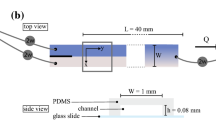Abstract
A numerical technique is presented that enables mass exchange at the liquid-solid interface region in a molecular simulation. Particles can be inserted and deleted in the solid region where interaction between the fluid and solid atoms is temporarily inactivated during the process. A simple momentum-increase scheme drives the inserted particles against the unfavorable free energy. The technique is efficient and stable for insertion of particles into dense and inhomogeneous regions. The thin film and sessile-drop evaporation phenomena are then investigated using the proposed technique that allows steady-state simulations. The evaporation coefficients for the nanoscale thin film and contact line were accurately and reliably measured. The evaporation coefficient near the contact line shows a discrepancy compared to that far from the contact line.
Similar content being viewed by others
References
M. P. Allen and D. J. Tildesley, Computer Simulation of Liquids, Oxford University Press (2017).
D. C. Rapaport and D. C. R. Rapaport, The Art of Molecular Dynamics Simulation, Cambridge University Press (2004).
G. S. Heffelfinger and F. Swol, Diffusion in Lennard-Jones fluids using dual control volume grand canonical molecular dynamics simulation (DCV-GCMD), The Journal of Chemical Physics, 100 (1994) 7548–7552.
I. C. Brooks and M. Karplus, Deformable stochastic boundaries in molecular dynamics, The Journal of Chemical Physics, 79 (1983) 6312–6325.
M. Berkowitz and J. A. McCammon, Molecular dynamics with stochastic boundary conditions, Chemical Physics Letters, 90 (1982) 215–217.
T. Cagin and B. M. Pettitt, Grand molecular dynamics: A method for open systems, Molecular Simulation, 6 (1991) 5–26.
R. M. Shroll and D. E. Smith, Molecular dynamics simulations in the grand canonical ensemble: Application to clay mineral swelling, The Journal of Chemical Physics, 111 (1999) 9025–9033.
H. Eslami and F. Müller-Plathe, Molecular dynamics simulation in the grand canonical ensemble, Journal of Computational Chemistry, 28 (2007) 1763–1773.
K. Mohamed and A. Mohamad, A review of the development of hybrid atomistic-continuum methods for dense fluids, Microfluidics and Nanofluidics, 8 (2010) 283–302.
E. Flekkøy, G. Wagner and J. Feder, Hybrid model for combined particle and continuum dynamics, EPL (Europhysics Letters), 52 (2000) 271.
N. G. Hadjiconstantinou and A. T. Patera, Heterogeneous atomistic-continuum representations for dense fluid systems, International Journal of Modern Physics C, 8 (1997) 967–976.
M. Mezei, Theoretical calculation of the liquid—Vapor coexistence curve of water, chloroform and methanol with the cavity-biased Monte Carlo method in the gibbs ensemble, Molecular Simulation, 9 (1992) 257–267.
R. Delgado-Buscalioni and P. Coveney, USHER: An algorithm for particle insertion in dense fluids, The Journal of Chemical Physics, 119 (2003) 978–987.
M. K. Borg, D. A. Lockerby and J. M. Reese, The FADE mass-stat: a technique for inserting or deleting particles in molecular dynamics simulations, The Journal of Chemical Physics, 140 (2014) 074110.
J. Sablić, M. Praprotnik and R. Delgado-Buscalioni, Open boundary molecular dynamics of sheared star-polymer melts, Soft Matter., 12 (2016) 2416–2439.
M. Han, Exchange of macromolecules and colloids in a dense medium: A molecular simulation method, Journal of Computational Physics, 395 (2019) 263–274.
K. Signe and B. Dick, Non-equilibrium Thermodynamics of Heterogeneous Systems, World Scientific (2008).
B. C. Garrett, G. K. Schenter and A. Morita, Molecular simulations of the transport of molecules across the liquid/vapor interface of water, Chemical Reviews, 106 (2006) 1355–1374.
S. Fujikawa, T. Yano and M. Watanabe, Vapor-liquid Interfaces, Bubbles and Droplets: Fundamentals and Applications, Springer Science & Business Media (2011).
N.-H. Kim, Enhancement of steam condensation on titanium corrugated tubes under vacuum condition, Journal of Mechanical Science and Technology, 33 (2019) 4023–4027.
D. H. Shin, D. Y. Kim, C. K. Choi and S. H. Lee, Quantitative measurements of nanoparticle layer thicknesses near the contact line region after droplet drying-out, Journal of Mechanical Science and Technology, 33 (2019) 967–971.
C. Cercignani, Rarefied Gas Dynamics: from Basic Concepts to Actual Calculations, Cambridge University Press (2000).
Y. Sone, Kinetic Theory and Fluid Dynamics Birkhauser, Boston (2002).
E. Koopman and C. Lowe, Advantages of a Lowe-Andersen thermostat in molecular dynamics simulations, The Journal of Chemical Physics, 124 (2006) 204103.
C. Lowe, An alternative approach to dissipative particle dynamics, EPL (Europhysics Letters), 47 (1999) 145.
G. Q. Xu, S. L. Bernasek and J. C. Tully, Stochastic trajectory studies of small argon cluster scattering from Pt (111), The Journal of Chemical Physics, 88 (1988) 3376–3384.
P. Yi, D. Poulikakos, J. Walther and G. Yadigaroglu, Molecular dynamics simulation of vaporization of an ultra-thin liquid argon layer on a surface, International Journal of Heat and Mass Transfer, 45 (2002) 2087–2100.
J. C. Tully, Dynamics of gas-surface interactions: 3D generalized Langevin model applied to fcc and bcc surfaces, The Journal of Chemical Physics, 73 (1980) 1975–1985.
T. Ishiyama, S. Fujikawa, T. Kurz and W. Lauterborn, Non-equilibrium kinetic boundary condition at the vapor-liquid interface of argon, Physical Review E, 88 (2013) 042406.
T. Ishiyama, T. Yano and S. Fujikawa, Molecular dynamics study of kinetic boundary condition at an interface between argon vapor and its condensed phase, Physics of Fluids, 16 (2004) 2899–2906.
T. Ishiyama, T. Yano and S. Fujikawa, Molecular dynamics study of kinetic boundary condition at an interface between a polyatomic vapor and its condensed phase, Physics of Fluids, 16 (2004) 4713–4726.
Acknowledgments
This work was supported by the Incheon National University Research Grant in 2016.
Author information
Authors and Affiliations
Corresponding author
Additional information
Minsub Han received his Ph.D. in Mechanical Engineering, majoring in Microscale Fluid Dynamics. His current interests include particle simulations applied to small-scale fluids and soft matter.
Rights and permissions
About this article
Cite this article
Han, M. Mass exchange at liquid-solid interface: a molecular simulation scheme applied to evaporation phenomena. J Mech Sci Technol 34, 3855–3862 (2020). https://doi.org/10.1007/s12206-020-0836-6
Received:
Revised:
Accepted:
Published:
Issue Date:
DOI: https://doi.org/10.1007/s12206-020-0836-6




